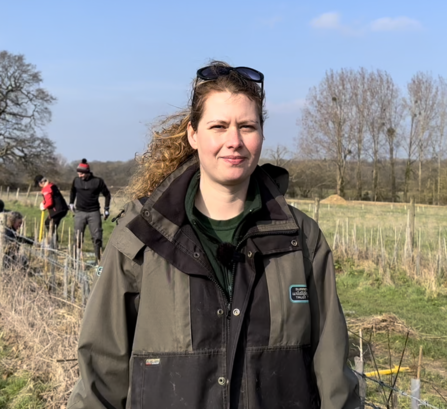I often get asked what I enjoy most about my job, and among other things, I really love the variety. No two days are the same, even if on paper they look like they’re going to be, so with that in mind, let me share with you a week in the life of an SWT Reserves Officer.
Monday - site patrols & planning
The week kicks off with a site patrol of one of our SANGs, (Suitable Alternative Natural Greenspace) Horsley Meadows, which is owned by The Land Trust and managed by SWT. We visit once a week and carry out a litter pick, infrastructure checks, and keep our eyes peeled for wildlife. We regularly spot birds of prey including Red Kites, Kestrel and Buzzards, and when the spring and summer months come around you can enjoy a cacophony of bird song as well as wildflowers and butterflies.
From here, it's off to one of our fabulous nature reserves for a recce to plan upcoming volunteer sessions. Most sites in the Central remit are chalk grassland sites, but we do also manage some small woodland sites. Working in different habitats is great because you get to learn about different management techniques and see a variety of different species thriving.
Once back at the office, it’s time for some essential admin work. This may not be the most exciting part of conservation, but there's a surprising amount of 'behind the scenes' admin that goes into planning sessions including ordering materials, liaising with other teams and companies, answering general enquiries, maintaining vehicles, tools and machinery, participating in meetings and lots and lots of planning.
Tuesday - chalk grassland scrub clearance
We’re lucky enough to look after some beautiful chalk grassland sites across Surrey. This habitat is important for its floral diversity, which in turn supports a vast array of invertebrate species, notably many species of butterflies. Our main focus over the autumn and winter months is therefore to clear scrub species such as hawthorn, blackthorn, dogwood and dogrose (plus more), in order to keep the chalk grassland open and looking its best.
We start preparing for our volunteer task as soon as we get in at 8.30am, packing the truck with tools and preparing the all-important tea kit. We aim to leave Pond Farm around 9.15am and meet our volunteers onsite for 10.00am. It’s then all hands-on-deck for a tough but rewarding day of scrub clearance, using heavy tools called tree poppers to grip the base of the tree and literally lever the roots out of the ground. Sometimes the roots are quite formidable and a mattook is required to loosen up the ground around the roots. The more root removed, the more successful the scrub clearance, and most would agree that a day of clearing scrub is a bit like a gym work out! The fun finishes at 3.00pm when we thank our team of volunteers for their hard work, and then head back to base where we unpack the tools and clean the tea kit.
Wednesday - woodland hazel coppicing
We're heading out for another volunteer session, this time at one of our woodland sites for some hazel coppicing. These tasks are always very popular with our volunteers and our small woodland sites tend to be very peaceful places... up until the team get the chainsaws started up anyway! While our volunteers use bowsaws and loppers to coppice the majority of the stools, SWT staff are on hand with the chainsaws to assist with the larger stems. Historically, coppicing was used to produce materials for use in other crafts, and wherever we can, we try to source our own stakes and binders for our hedgelaying sessions. In addition, coppicing is very valuable from a conservation perspective as it allows more sunlight to the woodland floor, which in turn benefits wildflowers such as bluebells, wood anemone and violets.
Thursday - Hedgerow Heritage hedgelaying
Hedgerow Heritage task day! These are our most popular volunteer sessions and spaces tend to book up within moments of becoming available. Hedgelaying is a heritage skill which involves cutting the stem so that approximately 20% remains intact, and then laying the stems down in the same direction. The cut stems should survive while the new growth becomes more established, resulting in a dense hedgerow which benefits countless species. It's also hugely beneficial to the hedgerow trees themselves as they are essentially rejuvenated and therefore live much longer than if they were allowed to become mature trees.
This season, we've been concentrating on hedgelaying an impressive 550m stretch of hedge on one of our Hedgerow Heritage partner's sites. It was by no means an easy hedge to work with as it had previously been laid in the opposite direction, plus some areas were incredibly dense and at 99% hawthorn was armed with some formidable thorns. But despite the challenges, the end product not only looks fabulous, but will also provide food, shelter and homes for many species of invertebrates, birds and mammals. I think there's something very rewarding about doing something that is both advantageous to nature, but also keeps a heritage craft alive, and it's always a pleasure to see how passionate people are about hedgelaying.


